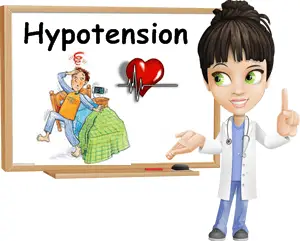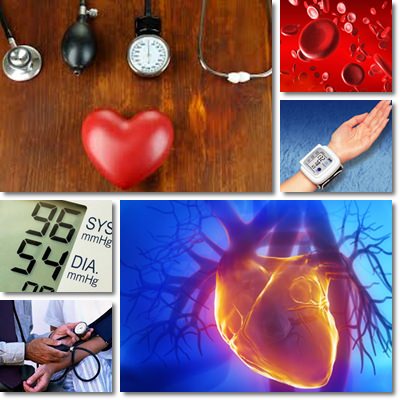Low blood pressure is also known as hypotension and is the opposite of high blood pressure. Low blood pressure occurs when both systolic and diastolic blood pressure readings are below the threshold of 120/80 mmHg (millimiters of mercury), in which systolic measures the pressure in the arteries while the heart is contracting while diastolic measures the pressure in the arteries while the heart is relaxing, in between heartbeats.
Generally, 120/80 mmHg is considered an ideal reading and believed to indicate an optimal state of health of the heart. But this being a too exact of a number, normal blood pressure readings are believed to go as high as 140/90 mmHg or as low as 90/60 mmHg.
Even so, variables may occur in some cases. Anything above 140/90 mmHg is considered high blood pressure or hypertension. Readings below 90/60 mmHg fall in the category of low blood pressure or hypotension.

Hypertension versus hypotension. High blood pressure is generally a nonspecific condition, meaning it is not necessarily caused by a disease, but rather a result of dietary and lifestyle factors such as a high salt intake, a low potassium intake, stress, alcohol consumption, obesity, sedentarism, exacerbated coffee consumption etc. Low blood pressure, on the other hand, is more likely to be triggered by an underlying medical condition such as anemia, endocrine imbalance, hemorrhage, diarrhea etc.
What is most interesting about the health impact of both hyper and hypotension is that while hypertension (high blood pressure) is but a nonspecific symptom, meaning that in most cases it is not caused by a health problem-proper, but puts us at risk of cardiovascular disease later on in life, hypotension (low blood pressure) is actually more likely to be a symptom of an existing medical problem that we just did not notice.
And while most of hypertension cases (over 90%) can be reversed with the help of dietary and lifestyle changes (if caught early on, before our cardiovascular system suffers too much damage), hypotension can be more problematic to address because it requires us to first deal with the health issue causing it. At the same time, it is worth considering that while people shouldn’t develop hypertension unless they are not taking care of themselves and watching their diet, there are many of us who are clinically hypotensive and still healthy.

What causes low blood pressure?
Low blood pressure is usually not problematic. But like any other clinically-significant symptom, it is best checked by a medical professional to exclude any potential underlying health problem. This being said, here are some the most and least common causes of low blood pressure (hypotension):
1) Anemia (due to folic acid, iron or vitamin B12 deficiency).
2) Low blood volume.
3) Hemorrhage.
4) Dehydration.
5) Prolonged episodes of diarrhea (they cause dehydration).
6) Insolation or sunstroke (due to dehydration and excessive vasodilation).
7) Potassium deficiency (potassium is an electrolyte that regulates blood pressure).
8) Too low of a sodium intake.
9) Arrhythmia.
10) Low heart rate.
11) Heart failure.
12) Heart valve problems.
13) Myocardial infarction (heart attack).
14) Certain medication (beta blockers, calcium channel blockers, alpha blockers, antidepressants, diuretics, Parkinson’s disease medication and so on).
15) Septic shock (severe infection) or anaphylactic shock.
16) Standing up suddenly (orthostatic hypotension).
17) Hypotension after eating (blood is sent to the intestines to help with digestion which may deprive vital organs such as the brain of sufficient blood after a meal).
18) Flammer’s syndrome (along with cold hands and feet).
19) Endocrine problems (adrenal hormones insufficiency).
20) Pregnancy.
Signs and symptoms
Low blood pressure is generally no reason for concern, unless it starts interfering with normal life. While symptoms such as occasional lightheadedness or dizziness, even fainting sensations when getting up to quickly from your bed or a chair are normal, actual fainting, pale skin others similar symptoms require a visit to the doctor’s. Here is a list of signs and symptoms that may accompany low blood pressure (hypotension):
1) Lightheadedness.
2) Weakness and fainting sensations, especially when getting up too quickly.
3) Fainting (syncope).
4) Nausea.
5) Blurred vision.
6) Thirst.
7) Fatigue.
8) Depression.
9) Headaches.
10) Concentration problems.
Other more serious symptoms associated with hypotension are more likely to be a result of more pressing underlying causes and may include:
1) Stiff neck.
2) Upper back pain.
3) Shortness of breath.
4) Chest pain.
5) Cough and sputum.
6) Pale, cold and sticky skin.
7) Indigestion.
8) Diarrhea.
9) Vomiting.
10) Seizures.
11) Loss of consciousness.
What to do about it
Hypotension may or may not require treatment. Treatment necessities depend primarily on what causes low blood pressure. Low blood pressure in itself (as a symptom) generally does not require treatment. However, if there is a specific medical condition causing low blood pressure, then that condition will require treatment. Treating the underlying cause should also help remedy the hypotension.
If you experience any of the above-mentioned symptoms, either alone or in combination, it is best to set an appointment with your doctor.
He or she will perform tests and try to figure out whether or not there is a health problem causing your hypotension. Based on results and diagnosis, an adequate treatment plan will be recommended to you.
As mentioned above, some people have low blood pressure naturally. While readings such as 90/60 mmHg might have some people feeling lightheaded or dizzy or even faint, people like me are not really bothered.
Depending on what I eat or do, my blood pressure may vary from 100/80 mmHg to as low as 60/50 mmHg. And according to my doctor, there isn’t anything wrong with me. I just have low blood pressure.
Unless it is particularly hot outside, I feel perfectly fine and can run about all day long and do everything I have to do. If it’s too hot, I make sure I drink enough water and fruit juices to keep hydrated, always remember to eat and take some magnesium and potassium supplements. Keeping hydrated and taking the supplements helps prevent a lower drop in my blood pressure as a result of hot weather. Other than that, I have a perfectly healthy heart.
The truth is, blood pressure can vary immensely from person to person and while most people fall in the normal category of around 120/80 mmHG, there are quite a few people who break the pattern. Athletes and sports enthusiasts, in general, are more likely to have lower blood pressure. Unless values are extremely high or extremely low, you should be okay. It is important to check your blood pressure regularly and learn what is normal for you.
An abnormal low blood pressure comes with symptoms of its own, so pay attention to what your body is telling you and report anything you feel is off to your doctor. If you have low blood pressure but you feel fine, chances are you are fine. If you have low blood pressure and do not feel okay, then it might be best to consult your doctor on the matter. Remember that if either your systolic or you diastolic blood pressure is low, you can consider you have low blood pressure (it doesn’t necessarily need to be both).
Blood pressure numbers
Generally, blood pressure readings revolve around the following values:
Low blood pressure: less than 90/60 mmHg
Normal blood pressure: 90/60 mmHg to 120/80 mm/Hg
Prehypertension: 120/80 mmHg to 139/89 mmHg
Stage 1 hypertension: 140/90 mmHg to 159/99 mmHg
Stage 2 hypertension: 160/100 mmHg and higher
Dangerous: 180/110 and higher (seek medical attention right away).
